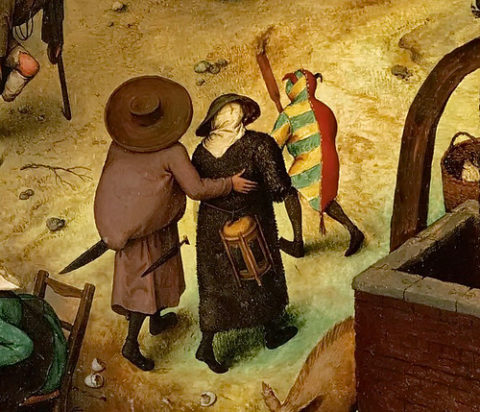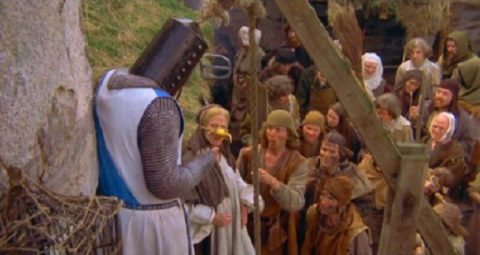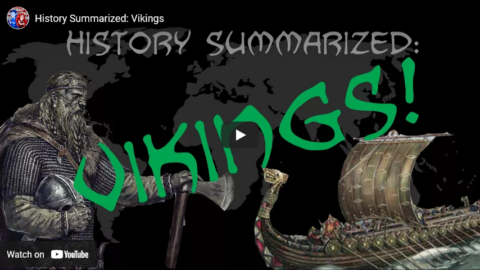seangabb
Published 27 Feb 2021The Crusades are the defining event of the Middle Ages. They brought the very different civilisations of Western Europe, Byzantium and Islam into an extended period of both conflict and peaceful co-existence. Between January and March 2021, Sean Gabb explored this long encounter with his students. Here is one of his lectures. All student contributions have been removed.
(more…)
May 17, 2022
The Crusades: Part 6 — The Loss of Jerusalem
May 14, 2022
The Crusades: Part 5 – The Role of Women
seangabb
Published 19 Feb 2021The Crusades are the defining event of the Middle Ages. They brought the very different civilisations of Western Europe, Byzantium and Islam into an extended period of both conflict and peaceful co-existence. Between January and March 2021, Sean Gabb explored this long encounter with his students. Here is one of his lectures. All student contributions have been removed.
(more…)
Nostalgia for the Middle Ages?
In Wrong Side of History, Ed West considers the apparent rising interest in Europe’s Middle Ages and Renaissance in popular culture:
The genre has been aided by developments in cinematic technology, allowing the sort of special effects that made such productions in the 1980s and 90s somewhat ridiculous. But there may be deeper cultural significance to this medieval revival, and it is one that evokes a strange discomfort in many people. Because, while the academic field of medieval studies has become a branch of progressive theology, medievalism as expressed through popular culture feels much more conservative, and to some minds, even fascistic. At the very least, it is “Right-coded”.
This discomfort often flares up whenever a new film or series attempts to capture our imagination, voiced in comment pieces warning us that they might be popular for the wrong reasons, among unsavoury elements.
This is what happened with Viking epic The Northman, despite director Robert Eggar’s impeccably progressive politics. “The Northman‘s 10th-century society appears to be uniformly white and firmly divided along patriarchal lines,” The Guardian warned: “Men do the ruling and killing; women do the scheming and baby-making. Its hero, played by Alexander Skarsgård, is not a million miles from the ‘macho stereotype’ Eggers complained of – a brawny warrior who settles most disputes with a sword and without a shirt. Skarsgård’s love interest, played by Anya Taylor-Joy, could be the far-right male’s dream woman: beautiful, fair-haired, loyal to her man and committed to bearing his offspring. Even before the film’s release, far-right voices were giving their approval on the anonymous message board site 4chan.”
Wow, expressing approval of a beautiful, fair-haired woman who wants to settle down and have your children? Better call Prevent!
According to a piece in the Economist, the new fixation with the Middle Ages dates to the September 11 attacks, when “the American far right … developed a fascination with the Middle Ages and the Renaissance — in particular, with the idea of the West as a united civilisation that was fending off a challenge from the East …
“The embrace of the medieval extends from the alt-right online forum culture that has exploded in the last few years to stodgier old-school racists. Helmeted crusaders cry out the Latin war-cry ‘Deus vult!’ from memes circulated on Reddit and 4Chan. Images of Donald Trump, clad in mail with a cross embroidered on his chest, abound. Anti-Islam journals and websites name themselves after the Frankish king Charles Martel, who fought Muslim armies in the 8th century, or the (slightly post-medieval) Ottoman defeat at Vienna.”
This concern is real enough that I’ve noticed a trend for medieval historians to introduce their books with what might be best described as health warnings, lest they be enjoyed in the wrong way. Neil Price’s The Children of Ash and Elm, for instance, comes with a declaration of values in the introduction:
Over the centuries, a great many people have eagerly pressed the Vikings into (im)moral service, and others continue to do so… I strongly believe that any meaningful twenty-first-century engagement with the Vikings must acknowledge the often deeply problematic ways in which their memory is activated in the present …
The Viking world this book explorers was a strongly multi-cultural and multi-ethnic place, with all this implies in terms of population movement, interaction (in every sense of the word, including the most intimate), and the relative tolerance required. This extended far back into Northern prehistory. There was never any such thing as a “pure Nordic” bloodline, and the people of the time would have been baffled by the very notion. We use “Vikings” as a consciously problematic label for the majority population of Scandinavia, but they also shared their immediate world with others – in particular, the semi-nomadic Sami people. Their respective settlement histories stretch so deeply into the Stone Age past as to make any modern discussion of “who came first” absurd. Scandinavia had also welcomed immigrants for millennia before the Viking Age, and there is no doubt that a stroll through the market centres and trading places of the time would have been a vibrantly cosmopolitan experience.
Well, I won’t be recommending Mr Price’s book to my friends at 4Chan, I can tell you that.
May 10, 2022
The Crusades: Part 4 — Life in Outremer
seangabb
Published 11 Feb 2021The Crusades are the defining event of the Middle Ages. They brought the very different civilisations of Western Europe, Byzantium and Islam into an extended period of both conflict and peaceful co-existence. Between January and March 2021, Sean Gabb explored this long encounter with his students. Here is one of his lectures. All student contributions have been removed.
(more…)
May 7, 2022
The Crusades: Part 3 — The Crusader States
seangabb
Published 6 Feb 2021The Crusades are the defining event of the Middle Ages. They brought the very different civilisations of Western Europe, Byzantium and Islam into an extended period of both conflict and peaceful co-existence. Between January and March 2021, Sean Gabb explored this long encounter with his students. Here is one of his lectures. All student contributions have been removed.
(more…)
May 3, 2022
The Crusades: Part 2 – The First Crusade
seangabb
Published 5 Feb 2021The Crusades are the defining event of the Middle Ages. They brought the very different civilisations of Western Europe, Byzantium and Islam into an extended period of both conflict and peaceful co-existence. Between January and March 2021, Sean Gabb explored this long encounter with his students. Here is one of his lectures. All student contributions have been removed.
(more…)
April 26, 2022
The Crusades: Part 1 – The Long Prehistory
seangabb
Published 23 Jan 2021The Crusades are the defining event of the Middle Ages. They brought the very different civilisations of Western Europe, Byzantium and Islam into an extended period of both conflict and peaceful co-existence. Between January and March 2021, Sean Gabb explored this long encounter with his students. Here is one of his lectures. All student contributions have been removed.
(more…)
April 25, 2022
QotD: The 15th century as a “mulligan”
I can’t really recommend Eamon Duffy’s The Stripping of the Altars or Johan Huizinga’s The Autumn of the Middle Ages as casual reading — you don’t have to be a specialist in the field to appreciate them (I’m not), but it surely helps. Nonetheless they’re worth a browse (provided you can find them), for a glimpse inside the head of a once vital, but now senescent, culture.
As I’ve written here before, the 15th century makes much more sense if you consider it a “mulligan” century, a do-over — an attempt to stuff the Early Modern cat back into the High Medieval bag in the wake of the Black Death. One cannot, of course, say that thus-and-such should’ve happened in history — history is the study of what actually did happen — but it’s clear that the Black Death was a giant hiccup in the otherwise “natural” progression from Middle Ages to Early Modern. It was all there in embryo in 1340; had the Black Death not hit the pause button for half a century, the great ructions of the early 1500s would’ve hit in the early 1400s. And they no doubt would’ve been a lot less severe, too — without the Black Death, the “Martin Luther” of 1417 might’ve been one of the great reforming Popes.
Read Huizinga or Duffy, and you get the overwhelming impression of bright children playing dress up. Everything’s cranked way past eleven. Like kids, they know that grownups do these things, and because they’re bright kids they have some idea why grownups do it … but not really, and the nuances utterly escape them. Huizinga tells the story of some churchman who ostentatiously drinks every drink he’s given in five swallows, one for each of Jesus’s wounds … obnoxious enough, but then he goes that characteristically Late Medieval extra mile — because both blood and water flowed from Christ’s side, he takes the second swallow in two gulps.
Knights vow to not open one of their eyes until they’ve met the Turk in battle. Another churchman rails against the kitschy little figurines found in burghers’ homes, a carving of the Virgin Mary with a door in her stomach. You open it up, and there’s the Trinity. Bad enough, but again the Late Medieval twist: He’s not upset at the figure as such (even though it’s the next best thing to idolatry); he’s pissed because you see the entire Trinity there, and not just Jesus, as is theologically proper. Speaking of Mary, academics debate, in all apparent seriousness, whether or not she was an “active participant” in Our Lord’s conception. And so on: Creeping to the Cross, endless novenas and rosaries and vigils, the whole spastically ostentatious public piety of the devotio moderna. The Imitation of Christ is great, everyone should read it, but imagine people doing all that in public, and not in the cloister as Kempis intended.
The old, exhausted, Alzheimery (it’s a word) dregs of a once vital and vibrant spirituality. Sound familiar?
Severian, “Alt Discussion Thread: Sacraments and Superstitions”, Founding Questions, 2022-01-18.
April 19, 2022
April 17, 2022
Queen Victoria’s Easter Cake
Tasting History with Max Miller
Published 23 Mar 2021Help Support the Channel with Patreon: https://www.patreon.com/tastinghistory
Tasting History Merchandise: crowdmade.com/collections/tastinghistoryFollow Tasting History here:
Instagram: https://www.instagram.com/tastinghist…
Twitter: https://twitter.com/TastingHistory1
Tiktok: TastingHistory
Reddit: r/TastingHistory
Discord: https://discord.gg/d7nbEpyLINKS TO INGREDIENTS & EQUIPMENT**
Sony Alpha 7C Camera: https://amzn.to/2MQbNTK
Sigma 24-70mm f/2.8 Lens: https://amzn.to/35tjyoW
Self Rising Flour: https://amzn.to/3cKxIoy
Almond Flour: https://amzn.to/3cGN9Ox
Mixed Peel: https://amzn.to/3lp6MP2
Currants: https://amzn.to/3bWEXe4
Castor Sugar: https://amzn.to/3vJMjJR
8 Inch Cake Pan: https://amzn.to/3f3fL7JLINKS TO SOURCES**
Pot Luck: British Home Cookery Book by May Byron: https://amzn.to/3r1qQIp
The Chronicle of Battle Abbey: https://amzn.to/3ePfrco
Cake: A Slice of History by Alysa Levene: https://amzn.to/2Q7JOAs**Some of the links and other products that appear on this video are from companies which Tasting History will earn an affiliate commission or referral bonus. Each purchase made from these links will help to support this channel with no additional cost to you. The content in this video is accurate as of the posting date. Some of the offers mentioned may no longer be available.
Subtitles: Jose Mendoza
#tastinghistory #easter #simnelcake
April 2, 2022
QotD: The pre-modern farming household
Looking at our peasant household, what we generally have are large families on small farms. The households in these farms were not generally nuclear households, but extended ones. Pre-Han Chinese documents assume a household to include three generations: two elderly parents, their son, his wife, and their four children (eight individuals total). Ptolemaic and Roman census data reveal a bewildering array of composite families, including multi-generational homes, but also households composed of multiple nuclear families of siblings (so a man, his wife, his brother and then brother’s wife and their children, for instance), and so on. Normal family units tended to be around eight individuals, but with wide variation (for comparison, the average household size in the United States for a family is 3.14).
At the same time that households were large (by modern standards), the farms they tilled were, by modern standards, very small. The normal size of a Roman household small farm is generally estimated between 5 and 8 iugera (a Roman measurement of land, roughly 3 to 5 acres); in pre-Han Northern China (where wheat and millet, not rice, were the staple crops), the figure was “one hundred mu (4.764 acres)” – essentially the same. In Languedoc, a study of Saint-Thibery in 1460 showed 118 households (out of 189) on farms of less than 20 setérée (12 acres or so; the setérée appears to be an inexact unit of measurement); 96 of them were on less than 10 setérée (about 6 acres). So while there is a lot of variation, by and large it seems like the largest cluster of household farms tend to be around 3 to 8 acres or so; 5 acre farms are a good “average” small farm.
This coincidence of normal farm size and family size is not an accident, but essentially represents multi-generational family units occupying the smallest possible farms which could support them. The pressures that produce this result are not hard to grasp: families with multiple children and a farm large enough to split between them might do so, while families without enough land to split are likely to cluster around the farm they have. Pre-modern societies typically have only limited opportunities for wage labor (which are often lower status and worse in conditions than peasant farming!), so if the extended family unit can cluster on a single farm too small to split up, it will (with exception for the occasional adventurous type who sets off for high-risk occupations like soldier or bandit).
Now to be clear that doesn’t mean the farm sizes are uniform, because they aren’t. There is tremendous variation and obviously the difference between a 10 acre small farm and a 5 acre small farm is half of the farm. Moreover, in most of the communities you will have significant gaps between the poor peasants (whose farms are often very small, even by these measures), the average peasant farmer, and “rich peasants” who might have a somewhat (but often not massively so) larger farm and access to more farming capital (particularly draft animals). […] Nevertheless, what I want to stress is that these fairly small – 3-8 acres of so – farms with an extended family unit on it make up the vast majority of farming households and most of the rural population, even if they do not control most of the land (for instance in that Languedoc village, more than half of the land was held by households with more than 20 setérée a piece, so a handful of those “rich peasants” with larger accumulations effectively dominated the village’s landholding […]).
This is our workforce and we’re going to spend this entire essay talking about them. Why? Because these folks – these farmers – make up the majority of the population of basically all agrarian societies in the pre-modern period. And when I say “the majority” I mean the vast majority, on the order of 80-90% in many cases.
Bret Devereaux, “Collections: Bread, How Did They Make It? Part I: Farmers!”, A collection of Unmitigated Pedantry, 2020-07-24.
March 29, 2022
Giving up vegetables for Lent
Felipe Fernández-Armesto on updating the traditional Christian observance of Lent for our virtue-signalling, social media age:

“Bruegel the Elder, Fight between Carnival and Lent, detail 6” by f_snarfel is licensed under CC BY-NC 2.0
For Lent, I am abstaining from vegetables. It may seem counter-intuitive, because “Carnival” or “Carni Vale” — which the English in their glum way call “Shrove Tuesday” and the French, more cheerfully, call “Mardi Gras” — means “Goodbye to Meat”.
The worldly, historic purpose of Lent is to eke out deficient livestock, doomed, unless slaughtered, to die, emaciated and inedible, on sparse or frozen pastures. Nowadays, however, vegetables seem a sacrifice both reasonable and pious.
If I wanted to be lampooned in Private Eye, I’d say that vegetables are the new meat: marketed as dietetically superior, and flattering to a moral form of snobbery.
Like meat in the old days, they are the preferred food of people who want to look down on the rest of us. Flesh and fish are now humbling meals, consumed in self-abasement. “Veganuary” and “Dry January” — wicked, secularist attempts to subvert the sanctity of Lent — repel me from conventional kinds of penance.
I want to defy the absurd propaganda of meat-haters, who try to shame the ill-informed into vegetarianism with mendacious allegations about the environmental cost of carnivorism. Scientifically, they’re on a par with Pythagoras’s denunciation of “passion proteins” and the meat-phobic campaigns of the nineteenth-century evangelists who hawked joyless, overpriced breakfast cereals.
I also want to expose the folly of people who, in flight from the butcher’s shop, grab textured soy concentrate from supermarket shelves: theirs is the idiocy of the ersatz. If you want something like meat, have meat. If you don’t want meat, have something unlike it. My sacrifice would be greater, of course, if I disliked rare steaks and juicy roasts. But I like vegetables, too. So that’s all right.
March 23, 2022
QotD: Fansplaining that feudalism is bad
One that continues to baffle me is the indefatigable enthusiasm of some fans for explaining to others that Barrayaran neo-feudalism is a terrible system of government, as if their fellow readers couldn’t figure that out for themselves. It seems to rest on an a-historical understanding, or simply a lack of understanding, of feudalism, a system that died out in our world five hundred years ago, to be replaced by geographically based national states. (Well, four hundred years ago, in Japan.) From the passion these readers bring to the table, one would gather they imagine insidious card-carrying Feudalists are dire threat to the lifeblood of our nation. I’m not sure I should tell them about the SCA.
Portrayal is not promulgation, people.
That said, I’ve spent thirty years learning that no writer, be they ever so clear and plain, can control how readers read, or misread, their texts. Reading is a dance, not a march. If some readers step on one’s feet, well, it’s still better than sitting by the wall … Usually.
Lois McMaster Bujold, “Lois McMaster Bujold on Fanzines, Cover Art, and the Best Vorkosigan Planet”, Tor.com, 2017-11-02.
March 7, 2022
QotD: Historical fiction and fantasy works usually leave out the vast majority of the people who did all the work
… there is a tendency when popular culture represents the past to erase not merely the farmers, but most of the commons generally. Castles seem to be filled with a few servants, a whole bunch of knights and lords and perhaps, if we are lucky, a single blacksmith that somehow makes all of their tools.
But the actual human landscape of the pre-modern period was defined – in agrarian societies, at least – by vast numbers of farms and farmers. Their work proceeded on this cyclical basis, from plowing to sowing to weeding to harvesting and threshing to storage and then back again. Religious observances and social festivals were in turn organized around that calendar (it is not an accident how many Holy Days and big festivals seem to cluster around the harvest season in late Autumn/early Winter, or in Spring). The uneven labor demands of this cycle (intense in plowing and reaping, but easier in between) in turn also provided for the background hum of much early urban life, where the “cities” were for the most part just large towns surrounded by farmland (where often the folks living in the cities might work farmland just outside of the gates). People looked forward to festivals and events organized along the agricultural calendar, to the opportunities a good harvest might provide them to do things like get married or expand their farms. The human drama that defines our lives was no less real for the men and women who toiled in the fields or the farmhouses.
And of course all of this activity was necessary to support literally any other kind of activity.
Bret Devereaux, “Collections: Bread, How Did They Make It? Part III: Actually Farming”, A Collection of Unmitigated Pedantry, 2020-08-06.
February 7, 2022
History Summarized: Vikings
Overly Sarcastic Productions
Published 14 Jul 2017Huge thanks to our friend Shad at Shadiversity! Check out his channel for historical weaponry and much more: https://www.youtube.com/user/shadmbrooks
Grab your swords and hop in your longboats, because it’s time to learn a thing or two about the Vikings!
This video was produced with assistance from the Boston University Undergraduate Research Opportunities Program.
Thanks to patron Karl Erik L Hoftaniska for suggesting this topic!
PATREON: www.patreon.com/user?u=4664797
MERCH LINKS:
Shirts – https://overlysarcasticproducts.threa…
All the other stuff – http://www.cafepress.com/OverlySarcas…Find us on Twitter @OSPYouTube!
From the comments:
Finn Chitwood
4 years ago
In the words of a brilliant Icelandic magazine: “Viking was a seasonal, temporary occupation, not an ethnicity.”






